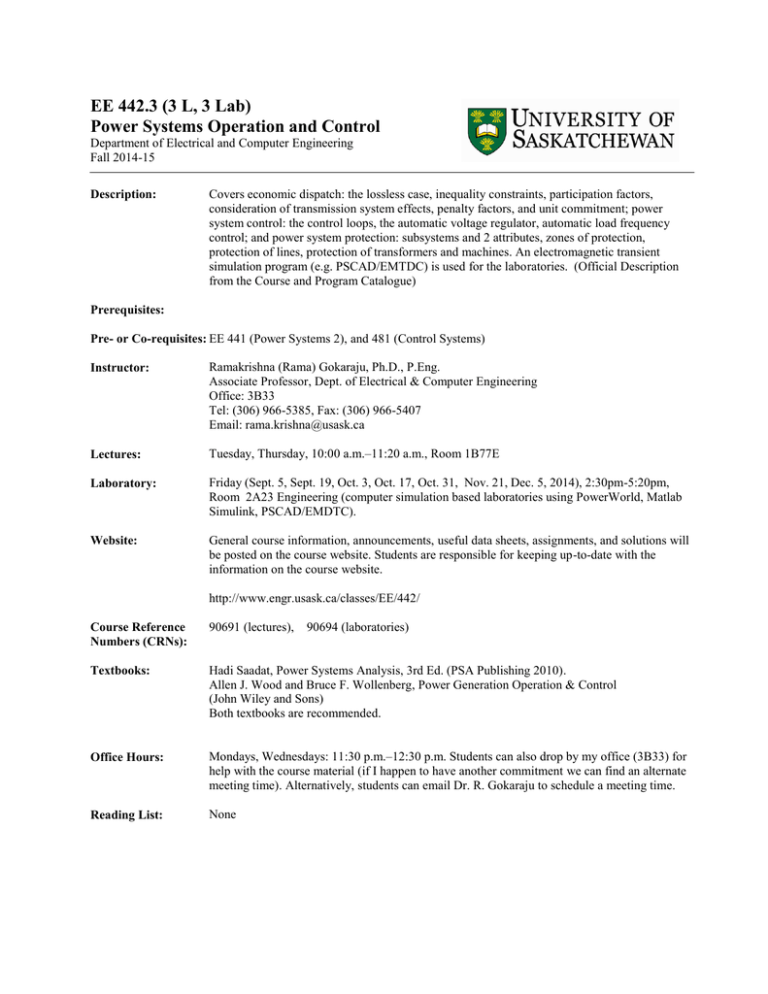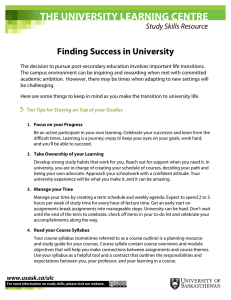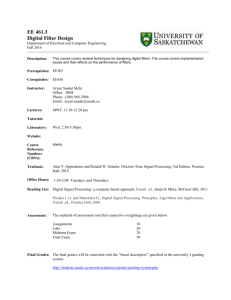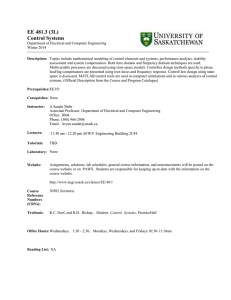EE 442.3 (3 L, 3 Lab) Power Systems Operation and Control
advertisement

EE 442.3 (3 L, 3 Lab) Power Systems Operation and Control Department of Electrical and Computer Engineering Fall 2014-15 Description: Covers economic dispatch: the lossless case, inequality constraints, participation factors, consideration of transmission system effects, penalty factors, and unit commitment; power system control: the control loops, the automatic voltage regulator, automatic load frequency control; and power system protection: subsystems and 2 attributes, zones of protection, protection of lines, protection of transformers and machines. An electromagnetic transient simulation program (e.g. PSCAD/EMTDC) is used for the laboratories. (Official Description from the Course and Program Catalogue) Prerequisites: Pre- or Co-requisites: EE 441 (Power Systems 2), and 481 (Control Systems) Instructor: Ramakrishna (Rama) Gokaraju, Ph.D., P.Eng. Associate Professor, Dept. of Electrical & Computer Engineering Office: 3B33 Tel: (306) 966-5385, Fax: (306) 966-5407 Email: rama.krishna@usask.ca Lectures: Tuesday, Thursday, 10:00 a.m.–11:20 a.m., Room 1B77E Laboratory: Friday (Sept. 5, Sept. 19, Oct. 3, Oct. 17, Oct. 31, Nov. 21, Dec. 5, 2014), 2:30pm-5:20pm, Room 2A23 Engineering (computer simulation based laboratories using PowerWorld, Matlab Simulink, PSCAD/EMDTC). Website: General course information, announcements, useful data sheets, assignments, and solutions will be posted on the course website. Students are responsible for keeping up-to-date with the information on the course website. http://www.engr.usask.ca/classes/EE/442/ Course Reference Numbers (CRNs): 90691 (lectures), 90694 (laboratories) Textbooks: Hadi Saadat, Power Systems Analysis, 3rd Ed. (PSA Publishing 2010). Allen J. Wood and Bruce F. Wollenberg, Power Generation Operation & Control (John Wiley and Sons) Both textbooks are recommended. Office Hours: Mondays, Wednesdays: 11:30 p.m.–12:30 p.m. Students can also drop by my office (3B33) for help with the course material (if I happen to have another commitment we can find an alternate meeting time). Alternatively, students can email Dr. R. Gokaraju to schedule a meeting time. Reading List: None Assessment: The methods of assessment and their respective weightings are given below: Assignments (~6 assignments) Laboratories Midterm Exam Final Exam Final Grades: 10% 15% 25% 50% The final grades will be consistent with the “literal descriptors” specified in the university’s grading system. http://students.usask.ca/current/academics/grades/grading-system.php For information regarding appeals of final grades or other academic matters, please consult the University Council document on academic appeals. http://www.usask.ca/university_secretary/honesty/StudentAcademicAppeals.pdf Course Content: MAJOR TOPICS: (Approximate Time Allotment) 1.Economic Dispatch & Unit Commitment (~12 hours) Lagrange Equations, Kuhn-Tucker Conditions, Load Flow Analysis Using PowerWorld Commercial Software, Computational Procedures/Considerations, Economic Dispatch Problem, Incremental Cost, Inequality Constraints, Optimal Dispatch with Losses Considered, LambdaIteration Method, Gradient Search Technique, Penalty Factor Considerations, Unit Commitment Problem, Spinning Reserve, Thermal Constraints, Priority-List Methods. 2. Power Systems Control (~12 hours) Generator, Load, Prime-mover, Governor Model, Governor Model, Tie-Line Model, Basic generator control loops, Feedback Control Systems (Transfer Functions, Closed-Loop Systems, Characteristic Equations, Stability Evaluations of Closed-Loop Systems), Turbine-Governor Response, Static Performance of Speed Governor, Generator Allocation, AGC Implementation, AVR, Exciter Model, AVR Dynamic Response, AVR - Rate Feedback Stabilizer, PID Controller, Design of AGC for a Single-Area and Two-Area Systems. 3. Power Systems Protection (~6 hours) Subsystems and attributes of protection systems, zones of protection, primary and backup protection, overcurrent relays, directional relays, ratio relays, differential relays, distance relays, pilot relays, design of overcurrent protection for distribution feeders, design of distance based protection for HV and EHV lines, protection of power transformers and generators. 4. Computer Based Relaying (~6 hours) Sine and cosine fourier series, digital filters, phasor calculations, short- and long-window algorithms, discrete fourier transforms. Assignments: Assignments will be handed out approximately every one or two two weeks, depending on how slowly/quickly the course content is covered in the lectures. Assignments must be submitted on time in EE 442 assignment box opposite to Room 2C94. Late assignments will not be marked and will be given a mark of zero. Tutorials: None Quizzes: None Exams: The midterm exam is scheduled on November 6 (Thursday), 6:00PM-8:00PM (room to be announced). 2-page formula sheet will be allowed for the mid term examination and 4-page formula sheet will be allowed for the final examination (no solved problems in the formula sheet are allowed). Programmable calculators are allowed but all other electronic devices are not allowed. Important Dates: Thursday, September 4, 2014 Thursday, Nov 6, 2014 Tuesday, December 5, 2014 Student Conduct: Ethical behaviour is an important part of engineering practice. Each professional engineering association has a Code of Ethics, which its members are expected to follow. Since students are in the process of becoming Professional Engineers, it is expected that students will conduct themselves in an ethical manner. EE 442 class begins Midterm exam (6pm-8pm) Last day of EE442 class The APEGS (Association of Professional Engineers and Geoscientists of Saskatchewan) Code of Ethics states that engineers shall “conduct themselves with fairness, courtesy and good faith towards clients, colleagues, employees and others; give credit where it is due and accept, as well as give, honest and fair professional criticism” (Section 20(e), The Engineering and Geoscience Professions Regulatory Bylaws, 1997). The first part of this statement discusses an engineer’s relationships with his or her colleagues. One of the ways in which engineering students can demonstrate courtesy to their colleagues is by helping to maintain an atmosphere that is conducive to learning, and minimizing disruptions in class. This includes arriving on time for lectures, turning cell phones and other electronic devices off during lectures, not leaving or entering the class at inopportune times, and refraining from talking to others while the instructor is talking. However, if you have questions at any time during lectures, please feel free to ask (chances are very good that someone else may have the same question as you do). For more information, please consult the University Council Guidelines for Academic Conduct. http://www.usask.ca/university_secretary/council/reports_forms/reports/guide_conduct.php Academic Honesty: The latter part of the above statement from the APEGS Code of Ethics discusses giving credit where it is due. At the University, this is addressed by university policies on academic integrity and academic misconduct. In this class, students are expected to submit their own individual work for academic credit, properly cite the work of others, and to follow the rules for examinations. Academic misconduct, plagiarism, and cheating will not be tolerated. Copying of assignments and lab reports is considered academic misconduct. Students are responsible for understanding the university’s policies on academic integrity and academic misconduct. For more information, please consult the University Council Regulations on Student Academic Misconduct and the university’s examination regulations. http://www.usask.ca/university_secretary/honesty/StudentAcademicMisconduct.pdf http://www.usask.ca/university_secretary/council/academiccourses.php Safety: The APEGS Code of Ethics also states that Professional Engineers shall “hold paramount the safety, health and welfare of the public and the protection of the environment and promote health and safety within the workplace” (Section 20(a), The Engineering and Geoscience Professions Regulatory Bylaws, 1997). Safety is taken very seriously in the laboratories by the Department of Electrical and Computer Engineering. Students are expected to work in a safe manner, follow all safety instructions, and use any personal protective equipment provided. Students failing to observe the safety rules in any laboratory will be asked to leave. Course Learning Outcomes: 1. 2. Students will be able to find optimized solutions for economic dispatch in power systems. Students will be able to understand the complexities involved in doing online economic dispatch. 3. Students will be able to gain understanding of generator unit commitment issues in power systems. 4. Students will able to design Automatic Generation for a Single Area System. 5. Students will be able to design Automatic Generation for a Two Area System. 6. Students will learn basics of control system stability and PID parameter tuning for Excitation Systems. 7. Students will learn design of overcurrent protection scheme for radial distribution systems. 8. Students will learn design of transformer differential protection. 9. Students will learn design of distance protection scheme for transmission lines. 10. Students will learn design of discrete Fourier transform filters for estimating the magnitude and phase angle of fundamental frequency voltage and current phasors for protection applications. Laboratory Learning Outcomes: 1. 2. 3. 4. 5. 6. Laboratory Class 1: After this lab, the students will know the basics of load flow studies. The students will also gain basic familiarity with a commercial software tool (PowerWorld) for load flow studies. Laboratory Class 2: After this lab, students will learn how to do economic dispatch study using a commercial software program (PowerWorld). Laboratory Class 3: After this lab, the student will be able to design a load frequency control system for a single area power system configuration using Simulink toolbox of Matlab. Students will also know the purpose of introducing a reset control action in the control loop. Laboratory Class 4: After this lab, the student will be able to design a automatic generation control system for a two area power system configuration using Simulink toolbox of Matlab. Students will also know what Area Control Error is. Students will also know how to bring the power flowing in the tie line to its base value after a load change in any of the areas. Laboratory Class 5: After this lab, the students will be able to do a basic control design of a generator excitation systems controller. The students will also understand the conflicting requirements between steady state response and dynamic performance improvement. Laboratory Class 6 & 7: After this lab, the students will be able to do a basic protection design (overcurrent protection) for radial distribution systems feeders. Students will also learn how to use a commercial available tool PSCAD/EMDTC for doing relay design. Attribute Mapping: Learning Outcome 1 2 3 4 5 6 7 8 9 10 A1 2 2 2 2 2 2 2 2 2 2 A2 2 2 2 2 2 2 2 2 2 2 A3 Level of Performance* Attribute** A4 A5 A6 A7 2 2 2 2 2 2 2 2 2 2 2 2 2 2 **Attributes: A1 Knowledge base for engineering A2 Problem analysis A3 Investigation A4 Design A5 Use of engineering tools A6 Individual and team work A7 Communication skills A8 Professionalism A9 Impact of engineering on society and the environment A10 Ethics and equity A11 Economics and project management A12 Life-long learning A8 A9 A10 A11 A12 *Levels of Performance: 1 - Knowledge of the skills/concepts/tools but not using them to solve problems. 2 - Using the skills/concepts/tools to solve directed problems. (“Directed” indicates that students are told what tools to use.) 3 - Selecting and using the skills/concepts/tools to solve non-directed, non-open-ended problems. (Students have a number of S/C/T to choose from and need to decide which to employ. Problems will have a definite solution.) 4 - Applying the appropriate skills/concepts/tools to solve open-ended problems. (Students have a number of S/C/T to choose from and need to decide which to employ. Problems will have multiple solution paths leading to possibly more than one acceptable solution.) Accreditation Unit (AU) Mapping: (% of total class AU) Math - Natural Science - Complementary Studies - Engineering Science 38.43 AU (100%) Engineering Design 16.47 (30%) Assessment Mapping: Methods of Feedback*** Component Weighting Assignments (~about 10% S, F 6-8) Laboratories (~7) 15% S, F Midterm Exam 25% S, F Final Exam 50% S ***Methods of Feedback: F – formative (written comments and/or oral discussions) S – summative (number grades) Learning Outcomes Evaluated 1-10 1, 2, 4, 5, 6, 7 1-6 1-10


